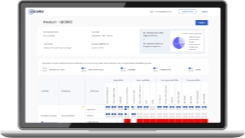
Your best source of talent is already within your organization. Upskilling your existing workforce through corporate training has become a critical necessity. Especially when facing the relentless need for skilled talent to meet the changing demands of projects, stakeholders, and entire industries.
Let’s be clear nobody enjoys mandatory training. Endless slides, outdated content, and uninspiring sessions drain enthusiasm faster than anything else. And if employees aren’t committed, what’s the point? Ineffective training doesn’t just waste time and resources; it squanders potential.
The solution? Engagement. When employees are truly engaged, training transforms. They’re not just attendees they’re active participants, eager learners, and invested contributors.
So, how do you make training sessions something employees look forward to, not dread? Let’s dive in.
The Importance of Employee Engagement in Corporate Training
Companies with well-structured employee training programs report 218% higher income per employee compared to those without formalized training. When employees receive the training they need and want, productivity levels rise by 24%.
These numbers highlight the vital role of keeping trainees engaged in training. When employees are involved, motivated, and connected to the learning process, the results are transformative.

6 Ways to Keep Trainees Engaged During Training
So, how can you design sessions that inspire participation and drive meaningful outcomes? Let’s explore strategies to keep employee engagement in training

1. Introduction Matters:
The introduction is your first and best chance to capture attention and set the stage for meaningful engagement. Start strong by being real, authentic, and approachable. Avoid diving straight into the content; instead, focus on building a connection and making your learners feel comfortable and involved from the beginning.
Learners care about their needs, not yours. Begin by encouraging them to share their expectations and insights. Ask open-ended questions like:
- What do you hope to gain from this session?
- How do you think this training will help you in your role?
This approach helps you understand their objectives and gives them a sense of ownership over the learning process. Then, be specific about what the audience will achieve by the end of the session.
The introduction is all about energy and enthusiasm. Show passion for the subject, create an inclusive space for dialogue, and encourage your learners to feel invested in their growth from the very first moment.
2. Make the Training Relevant
Irrelevant training is one of the biggest barriers to training engagement. After meeting with leadership, you'll often receive a list of skills or topics they believe employees should learn. Your role as a trainer is to defend the employees' interests and ensure the training focuses only on what's truly relevant to their roles and goals. Filter out unnecessary or outdated content if it doesn't add value or solve a real problem for the learners, it doesn't belong in the session.
The key is to respect your learners' time and attention. Make the training as painless as possible by distilling complex concepts into simple, actionable lessons. Focus on practical skills and insights that learners can immediately apply in their day-to-day work. When employees see the relevance and benefit of the training, they'll be more engaged, motivated, and willing to participate actively.
3. Include Interactive Activities
Nobody likes to sit through long, monotonous training sessions. To engage learners, it’s essential to make the training interactive and dynamic. A great way to structure your session is by using the 10-20 rule: for every 10 minutes of instructor-led teaching, allow 20 minutes for
participants to interact, discuss, or practice what they’ve learned.
Interactive activities help break the monotony and make learning memorable. Use problem-solving exercises and role-playing activities to keep participants engaged. Training through scenarios is one of the most effective methods for learning.
Gamification is another powerful strategy. Introduce team-based activities, rewards, and competitions to improve engagement in your employee training. Gamification creates a natural urge to win, helping learners absorb lessons subconsciously. Afterward, encourage self-reflection to uncover insights.
Last but not least, make your sessions visually engaging. This doesn’t mean bombarding learners with 200 slides of PowerPoint. Instead, use the room creatively and effectively. Move around, use props, and involve learners in demonstrations. This physical interaction keeps energy levels high and fosters a sense of connection.
4. Use Storytelling
Real-world examples and stories are powerful tools for keeping employees engaged during training.
Storytelling and humor are particularly effective. You don’t have to be a stand-up comedian, but injecting light humor into your stories can make the learning process enjoyable and keep participants attentive. A well-told story illustrates complex ideas in a way that resonates with learners and leaves a lasting impression.
Case studies are another great way to explain concepts. They help learners connect theoretical concepts to practical situations, making the training more relatable.
Using relatable learning examples and engaging stories explains concepts effectively and helps create a stronger emotional connection with your audience.
5. Make Training Inclusive
Effective training isn’t one-size-fits-all. Different people learn in different ways some thrive with visual aids, while others prefer hands-on activities or auditory explanations.
To maximize employee engagement:
- Mix Delivery Methods: Use videos, infographics, live demonstrations, group discussions, and interactive tools to cater to diverse learning styles. This variety keeps sessions engaging and inclusive.
Accessibility is another critical, yet often overlooked, aspect of effective training. Have you ever considered the following group of people in your training:
- For Hearing Impairments: Provide captions or transcripts for all video and audio content to support participants with hearing challenges.
- For Color Blindness: Design visuals carefully. Avoid relying solely on color to convey meaning; use patterns, shapes, or text labels to ensure clarity.
- For Cognitive Diversity: Break down complex concepts into smaller, manageable parts to prevent overwhelm and improve comprehension.
Lastly, ensure your tools and platforms are user-friendly. Clunky systems and poorly designed interfaces can frustrate learners and lead to disengagement.
By addressing these factors, you create an inclusive learning experience that respects individual differences. Accessible and thoughtfully designed training empowers employees to succeed and ensures you keep employees engaged during training.
6. Continuous Training Improvement
To keep your training engaging and effective, it's crucial to embrace a culture of continuous improvement. This involves evaluating results and using feedback to refine and enhance every session.
Measure Results Beyond the Session: Traditional evaluation forms handed out at the end of a session whether physical or digital only provide a snapshot of feedback. While these forms are useful, they often fail to capture the real impact of training.
The ultimate goal is to measure outcomes after the class:
- Behavioral Changes: What specific behaviors or habits have employees adopted after training?
- Performance Metrics: Track tangible improvements such as increased sales, enhanced customer satisfaction scores, or reduced errors. For example, "Sales increased by 10% after our training program."
- ROI for the Organization: Tie the training outcomes back to organizational objectives, demonstrating clear value and impact.
Follow-Up with Participants: Engagement doesn't end with the session. Reach out to participants post-training to gather genuine insights:
- Meaningful Conversations: Frame your follow-ups with curiosity and authenticity. For example:
- "We're reviewing our training for the next session and really want to know what worked well and what we could improve on. Could you share your thoughts?"
- Valuable Feedback: Employees often provide practical suggestions and highlight areas for improvement when approached with sincerity.
Debrief and Improvise: Make it a standard practice to debrief after every training session. Analyze what worked and what didn't:
- Refine, Don't Redo: Continuous improvement doesn't mean overhauling everything from scratch. It's about fine-tuning existing elements to make each session better.
- Adapt Activities: If an activity doesn't resonate with learners, tweak or replace it with something more effective.
- Correct Mistakes: Identify and fix any errors or missteps from the previous session. Small adjustments can lead to significant engagement boosts.
Training should be treated as a dynamic process, not a static event. By consistently iterating and adapting based on feedback, you can ensure your training remains relevant, engaging, and impactful.
Conclusion
Learner engagement is crucial for effective corporate training. It unlocks employees' potential and leads to improved knowledge retention, productivity, problem-solving abilities, and commitment to organizational goals. By understanding learner preferences and implementing research-backed strategies, organizations can design engaging training programs.
Incorporating interactive elements, providing real-world relevance, personalizing learning, and leveraging technology all enhance engagement. Active participation, timely feedback, and a supportive learning environment further promote engagement. Assessing engagement helps measure effectiveness and make necessary adjustments. Overall, prioritizing learner engagement drives success and growth in organizations.
Here is a blog to know the types of employee training program to have a productive workforce
Read More: Types of Employee Training to Enhance your Workforce.
Begin your journey towards fostering growth and development with Edstellar's comprehensive platform for instructor-led training. Empower your employees and cultivate a culture of continuous learning to drive your organization's success in today's dynamic business landscape.
Request a demo or fill out the inquiry form on our website to ex plore how our all-in-one platform can benefit your specific business requirements.
Reach out to us at business@edstellar.com to take the first step towards elevating your organization's training initiatives. Together, let's embark on a path of continuous growth and success.
Explore High-impact instructor-led training for your teams.
#On-site #Virtual #GroupTraining #Customized
Edstellar Training Catalog
Explore 2000+ industry ready instructor-led training programs.

Coaching that Unlocks Potential
Create dynamic leaders and cohesive teams. Learn more now!


Want to evaluate your team’s skill gaps?
Do a quick Skill gap analysis with Edstellar’s Free Skill Matrix tool

Stay informed on L&D best practices
Get periodic updates on learning and development industry trends, expert insights, success stories and innovative training practices from Edstellar.
.svg)
Featured Post
.webp)
Contact Us
Submit your Training Requirements below and We'll get in touch with you shortly.
.svg)



.svg)
.svg)
.svg)
.webp)
.svg)

.svg)
.svg)
.svg)

